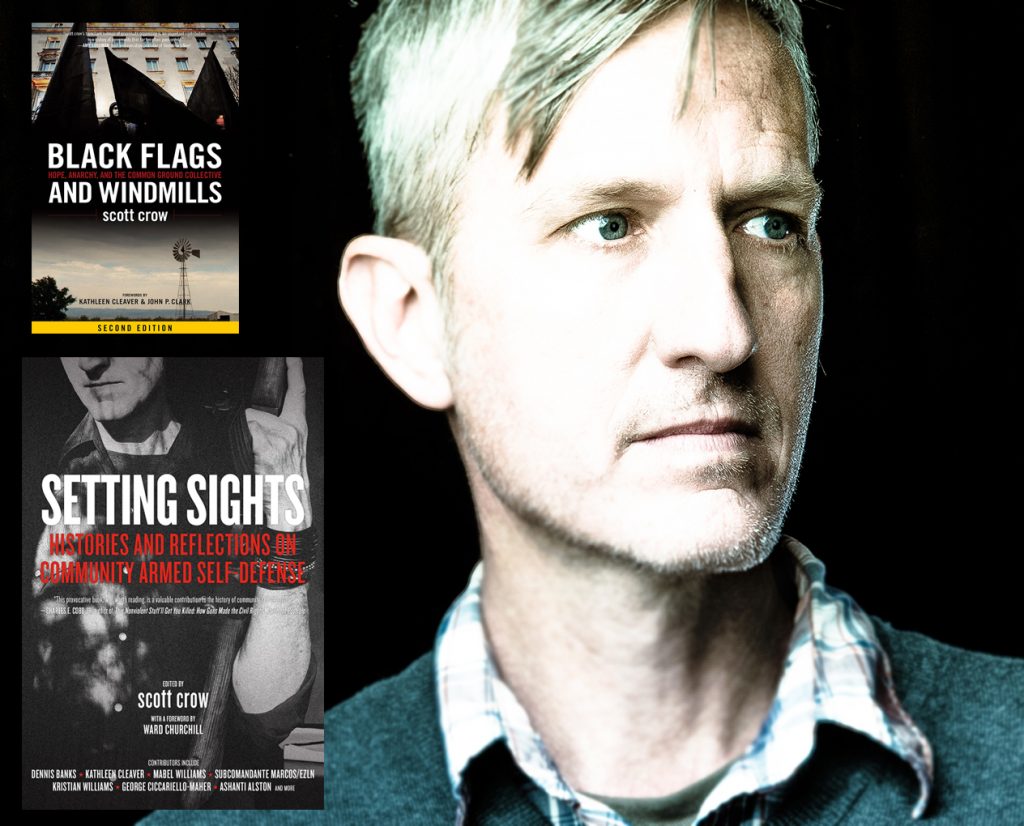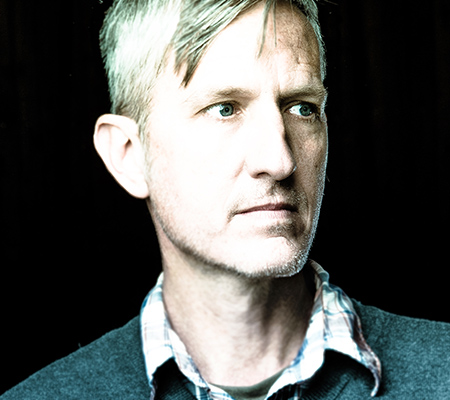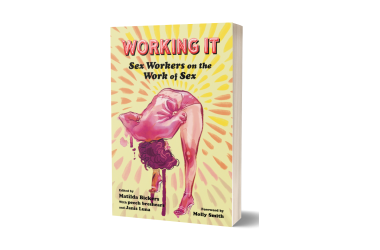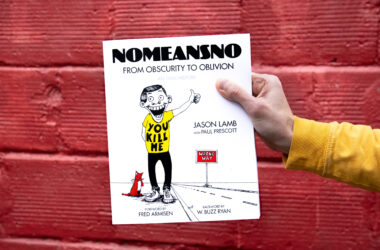
by Alpine Anarchist Productions
May 2012
For those not familiar with Common Ground Relief: can you tell us about the project in a few sentences?
Common Ground Relief was the largest anarchist-inspired organization in modern U.S. history. We combined many anarchist/horizontal practices and principles throughout the organization including direct action, mutual aid, autonomy, and participatory democracy. Our motto was “solidarity not charity,” which was the idea that we didn’t want to just help people, but to actually support them in rebuilding their communities and their own political power and self-determination from below. We did this by providing aid and basic infrastructure to assist people getting on their feet – as the Black Panther Party called it, “survival programs pending revolution”.
In 2011, your book Black Flags and Windmills: Hope, Anarchy, and the Common Ground Collective was released. Can you tell us what the book is about and explain the title?
The book is a combination of several elements. It’s part personal memoir of how an organizer from a working-class background from Texas ended up in New Orleans, and part an organizing manual of how to look at organizing with elements of “little-a anarchism” as a path for transforming civil society.
The title is an allusion to two things. The first is the black flags that anarchists have carried throughout their long storied histories worldwide. The second is my personal affinity to feeling like the Miguel de Cervantes character Don Quixote. All my life I have been a dreamer and fighter against injustice. Sometimes I have slain giants and other times just chased windmills.
If we are talking about self-management, it seems that you were facing extraordinary circumstances in New Orleans. Most self-managed projects, whether it is workers’ co-ops or rural communes, self-manage in a framework set by governmental institutions and the capitalist market. It appears that when you set up Common Ground Relief, the only framework you had were the people—the institutions and the market had disappeared almost entirely. Is this perception correct?
We were self-managed from the beginning. For us it was never a question of whether we would be or not. The question for us was how would we set it all up from the models available? I had a lot of experience within horizontal/anarchist organizations over the years and had used quite a few different models, but could not decide which would be the most appropriate one for this context. My personal experience within large and small groups—both open and closed—had led me to only participate in small, closed collectives. I believe this is the only way that we can really balance internal power dynamics, build true trust amongst the participants, and develop strong political praxis based on shared understood principles. But what we were embarking on was a scale that was far beyond the largest open assemblies any of us had ever participated in, with a wide spectrum of people. We actively sought out more experienced anarchist organizers who began to come to the area, which allowed us to draw on all of our collective historical experiences. Over the first three years we experimented with many different models with varying degrees of success, challenges, and some failures. We were drawing on common threads from the traditions, ideas, and histories of three somewhat disparate movements: the Black Panther Party, the Zapatistas, and anarchism (specifically the Spanish anarchists of the 1930s). We were drawing from their internal organizing experiences as well as the connected programs and projects.
How was working with Common Ground Relief different from other self-management projects you have been involved with?
There are few “professional” horizontal worker cooperatives or collectives within the United States. Additionally, there is not much government “support” for these structures. In most cases the hierarchical bureaucracies of the state find them to be confusing. In the United States, most anarchist/horizontal collectives are volunteer-based with a few worker cooperatives that are truly democratic. The grassroots is where the culture of power-sharing goes on. There has been very little support for horizontal cooperatives or self-management on the government level. Most of it has only been in certain cities or regions, with a few states that have laws that either recognize it or support its growth. That is changing, but only slowly and with much government confusion.
My own personal experiences both in activism and in the work world have shown me that bottom-up collective organizing with many perspectives, experiences, and thoughts has been more effective than relying on one person or small group of people to plan and direct something. Common Ground wasn’t always completely horizontal, but that was the ideal we tried to attain. We operated most of the projects like “affinity groups” under an umbrella of the Common Ground Collective. Some of the others—like the health clinics for example—operated mostly autonomously. We were a network where we shared principles and resources. In all of these projects and programs we shared information while consulting and operating in coordinated efforts to support the residents of New Orleans and help them build their power from below.
It is important to know that these structures were fluid, morphing and changing over time. We didn’t always have a clear blueprint of what the organizational structures were while we were in them. They were very organic, every time we formalized them, something would lead us to change or fine-tune them. Then, there were the hierarchal tendencies within the organization, which always caused tensions within the core coordinators and how we operated. It was largely borne of four factors.
First, there were the people who didn’t have experience with anarchist organizing or self-management. This was by far the largest grouping. In the United States, there is not much experience in participatory democracy or sharing our voices expect in small isolated spaces like small collectives, in tree-sits, or mass summits for example. And once out of those spaces, people have to return to their work with a boss or landlord etc. There isn’t a continuum of exercising those voices.
Second, some people didn’t value it. They had bad experiences with bad horizontal processes or just completely disagreed and wanted to be the “the leader” of something. It’s hard to break those patterns which are reinforced and rewarded in civil society.
Third, we often executed really bad processes within many of the open meetings due to lack of experience or group dynamics; blurring the lines between where concrete decisions needed to be made and where spaces were opened for peoples’ voices to be heard, while achieving neither.
Fourth, some of our administration or projects were very centralized by necessity. Some examples were the security teams, the finances of the organization, and long-term visions or projects. These were things that were held to a smaller group to keep relative control due to security, health of the organization, or allocation of our scarce resources.
While some people say that disasters bring out the best in people, others like to cite Lord of the Flies, suggesting that you actually get to see the worst in people. What did you see in New Orleans?
I saw both extremes while there. I saw chaos on one hand where situations were out of control and people were desperate enough to do desperate things for their own survival—especially in the early days. But I have to say that of the thousands of people I interacted with, this was the minority. The white vigilantes and the police would be extreme examples of the “Lord of the Flies” to me. But the majority of what I did see—the part that gave me absolute love of humanity—were those with absolutely nothing, who shared what little they had. People realized quite quickly when they were left to die that they would have to help each other and they did. If someone who had lost everything had a bottle of water, they would give it to someone who needed it more— just because they asked. It was mutual aid and cooperation for survival that morphed into rebuilding their lives together.
I also experienced people begin to self-organize without leaders or governments. In political terms, it was direct action and mutual aid. In these cases neighbours organized their own search and rescue missions of people trapped, distributed supplies to those with the greatest need, and later worked to decide what they wanted for the future. People put aside their differences when it mattered for a common good.
That phenomenon is illustrated historically here in the United States by a wonderful book from my friend Rebecca Solnit called A Paradise Built in Hell: The Extraordinary Communities That Arise in Disaster. It gives numerous examples about disasters leading to growing social movements. Hurricane Katrina’s aftermath was one of those examples, just like the Mexico City earthquake in the 1980’s.
If it is true that disasters, or severe crises, mainly strengthen principles of solidarity and mutual aid, what are the political lessons we can learn from this? After all, it would be cynical to hope for more disasters and crises just to see more solidarity and mutual aid.
We, as movements, are excellent at reacting to socio-political situations and mobilizing under crisis as I talked about earlier. The biggest challenges I see, and what I want to us to do, are to create these spaces, infrastructure, and movements without reacting, without the crisis, without disaster. If we have these pieces in place—even on small scales—and long-term goals or strategies, we can build grassroots power and have more capacity to resist Power when the crisis situations arise. We can build solidarity and mutual aid on small scales in all of our communities. That isn’t always going to be exciting, but it can provide communities with great power.
Given the unique circumstances under which Common Ground Relief was founded: what are the lessons to be learned for self-management in everyday life?
Some things I think I have drawn from this are:
* We need to recognize that we have incredible decentralized networks within horizontal/anarchist movements that can mobilize effectively and well with great flexibility.
* We need more ongoing projects on larger scales that are networked so that when crisis does occur we don’t have to re-invent everything. Networked projects or groups could plug in more easily to something on the ground.
* We need to create movements built on long-term strategies, not reactionary politics.
* We need, as movements, to connect the struggles on a daily basis not just in solidarity, but in actual day-to-day organizing that resists Power and builds counter-institutions simultaneously.
* We need to recognize that people in the real world will never look like our ideal politics and we need to meet people where they are. Otherwise we are always going to be relegated to being a subculture or, worse, a vanguard.
Perhaps most important is the belief that we can do things for ourselves as individuals and communities. That we absolutely do have the collective power to make sweeping changes across the world and in our lives without appealing to Power. It’s like that old cliché Think global but act local, where we need to connect and support struggles elsewhere but recognize that the changes we are proposing need to be done, and can be done, collectively in our own backyards.
Participatory democracy takes practice and commitment to unlearn the past and to learn new things about ourselves. It takes time to unwind all of our habits, prejudices, and biases, while learning to hear others differently and learning to trust our own voices about decisions.
It is also important to recognize the Zapatista saying that “We are building the road by walking”. The path is the journey to revolutionary change. We will make mistakes along the way, but it’s okay, we will continue walking.
We may not be able to stop global capital from destroying the planet, but we can still create pre-figurative communities and projects where we change our relationships with each other and the environment, restructure our local food and water security, rethink how we do or don’t use energy, how to defend our communities, create alternative economies and counter-institutions, reshape our work, culture, arts, and child care, etc.
You’ve been on book tours with Black Flags and Windmills, sharing your experiences with people across the U.S. What have the reactions been like?
Overwhelmingly positive. I hadn’t left Texas since 2006. I was working on the book and recovering from the traumas of New Orleans and its aftermath. I had no real gauge on how the ideas, the history, and the book would be received. I am grateful for the engaging dialog that ensues in every city, small or large, where I present the book. My presentation is unusual in that it has roots in the book but goes far beyond it. I ask a lot of questions about our current movements and challenge us to begin to think differently about who we are and how we engage in transformative politics for the future. Communities everywhere are thinking about or acting on some of these ideas; I am just giving them a language and narrative.
The other thing that I have found is how fast we forget our radical histories. In such a short time the history of New Orleans has been largely forgotten except superficially – like the levees’ failure, the government’s failed response and sheer brutality. But even in radical circles, the bottom-up resistance to oblivion was not known that well, especially not the grassroots organizing of Common Ground and all the other groups who were doing work in the region. I think my book is creating an opening to re-examine those experiences and histories, which I hope will widen and continue. I believe there is a lot of practicality that is relevant to the Occupy movements and other horizontal efforts today and for the future.
How strong are notions of self-management in the U.S. today in general? What do you expect from the future?
It has been gaining ground for the last twenty-thirty years but has been moving at hyperspeed for the last ten or so. It reaches from volunteer collectives to professional non-profits to businesses that are all examining, or re-examining, the way we make decisions and how power sharing affects our work and lives.
Where is Common Ground Relief today? And where are you?
Common Ground Relief is still very much around, albeit in a smaller capacity than it once was. The anarchist heyday is over, as it has become a more traditional grassroots non-profit. We made a conscious effort in 2008 to scale back. That combined with the forces of the large NGO movement for funding sources led it to becoming much more traditionally structured, but still with the “solidarity not charity” analysis throughout its programs.
I still live in Austin, Texas, where for the last five years I have stayed busy working a “green collar” manual labour job at an anarchist recycling worker cooperative, co-founded another worker coop thrift store called Treasure City Thrift, and consult with others on building horizontal worker coops as alternative economic engines to fund community-based projects. I also contended with being labelled a “domestic terrorist’ by the U.S. government and political far right, outing a “friend” as an undercover FBI agent, and dealing with all of the repercussions around it. I have also continued to consult with various Occupy camps and other groups on some of the best horizontal practices for power sharing, decision-making processes, etc., as they continue to build their grassroots political power.
Let’s say you had three sentences to summarize the most valuable personal lessons from Common Ground Relief: what would we get to hear?
That ordinary people—you, me, and everyone else—compelled in extraordinary situations can do amazing things beyond what we can imagine. That we should continue to do so. And that our time to do something is now because our collective futures are unwritten.






